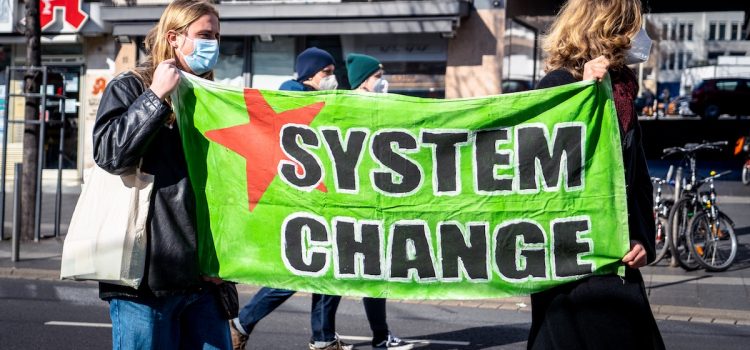

This article is an excerpt from the Shortform book guide to "American Marxism" by Mark R. Levin. Shortform has the world's best summaries and analyses of books you should be reading.
Like this article? Sign up for a free trial here.
Is the environmental justice movement an enemy of capitalism? Does the movement promote real science or just political ideology?
Mark Levin believes that the environmental justice movement threatens prosperity. He argues that the movement uses faulty science to feign a crisis in order to grab more control.
Read more to understand the argument that Levin presents in his book American Marxism.
The Environmental Justice Movement
The second major ideological movement of American Marxism is environmental justice. Levin claims that the environmental justice (EJ) movement attacks the systems that make America great and will thrust the nation into economic ruin if they succeed. In particular, Levin says that the movement opposes free-market capitalism—the system that has made America the greatest country in the world—as well as economic growth itself.
Levin claims that the environmental justice movement promotes anti-capitalism, or what they call “degrowth.” They believe that American capitalism has led to an unsustainable rate of growth through which natural resources are being depleted and carbon emissions are increasingly polluting the atmosphere. They advocate reducing production to a minimum to conserve resources and minimize pollution. As a result, they oppose many of the technological advances that make life better, like cars and modern agriculture.
(Shortform note: Levin argues that the EJ movement is dangerous because they promote degrowth. However, there are numerous environmental justice organizations and sub-movements that aren’t degrowthers. The degrowth movement is a specific branch of the environmental justice movement and doesn’t represent the interests and goals of the movement as a whole.)
While most degrowth organizations are grass-roots, many of their ideas have leaked into mainstream left-wing politics such as the Margarita Declaration on Climate Change and the Green New Deal (GND). Levin describes the GND as a Marxism-inspired bill that, in part, calls for net-zero greenhouse gas emissions, meeting America’s entire power demand through renewable energy, overhauling the American transportation system, providing jobs with “family-sustaining wages” to all people in America, and eliminating unfair business competition from monopolies.
Levin says that these goals are outlandish and impossible to accomplish because they undermine American free-market capitalism and private property rights, and they’re astronomically expensive, costing up to $93 trillion over 10 years. This would be yet another step toward Marxist totalitarianism.
| Predicted Impacts of the Green New Deal Levin argues that the GND is dangerous because it’s unaffordable and will undermine American capitalism and private property rights. However, some experts argue that Levin’s cost estimate may not be accurate and provide further details to help us contextualize his argument. While these experts agree that the GND is expensive, their estimations differ from Levin’s. Costs are estimated to be closer to $50 trillion, not the $93 trillion Levin quotes. However, they elaborate that ultimately, economists don’t have enough data to accurately measure how this cost would affect the economy. Additionally, while implementing the plan would be expensive, the impacts of climate change will be costly, too. This means the GND might even make the economy better in the long run—while it will be a large out-of-pocket expense, some argue that it will avoid long-term climate-induced economic decline, eventually pay for itself through energy sales, and create numerous jobs in the process. In regard to capitalism, some experts further explain that contrary to Levin’s claims, many supporters of the GND don’t promote degrowth, but rather support “inclusive growth.” While inclusive growth would limit harmful industries like mineral extraction, it would create a more sustainable and stable capitalist economic system through the expansion of the clean energy industry. And, while Levin doesn’t fully elaborate on how the GND would impact private property rights, experts explain that it may require households to rely more on green energy and make climate-resilient upgrades to minimize their carbon footprint, like installing window shades or painting rooftops with light-reflecting paint. |
The Science Behind the Environmental Justice Movement Is Faulty
Levin continues to argue that the “climate science” that the EJ movement is based on isn’t real science but rather political ideology framed as science. Levin argues this point by seeking to debase the two most prominent arguments that point to human-induced climate change—the depletion of natural resources and increasing carbon dioxide emissions.
Regarding the depletion of resources, Levin argues that humans haven’t even scratched the surface of the natural resources available on the earth. Therefore, we don’t need to worry about depleting them. He elaborates that the earth is made entirely of natural resources and that human intelligence and innovation will continue to develop new ways to access these resources.
(Shortform note: While Levin argues that we don’t need to worry about our use of resources, many experts disagree. They explain that humans are using up the earth’s resources at an unsustainable rate, roughly 1.7 times faster than the earth can regenerate them. Not only does our use of resources increase carbon emissions that lead to global warming, but it also contributes to 90% of biodiversity loss and water loss. Biodiversity—the variety of different plants and animals on earth—is essentially what allows humans to thrive. If even one species goes extinct (decreasing biodiversity), it can have an outsized impact on the ecosystem, threatening the loss of clean air, fresh water, high-quality soil for growing crops, and so on.)
Regarding carbon dioxide emissions, Levin argues that carbon dioxide isn’t a pollutant and that the science linking it to global warming isn’t credible. He elaborates that carbon dioxide isn’t a pollutant because it’s necessary for life—plants absorb it and create more oxygen for humans. And, while leftist scientists claim that carbon emissions are unnaturally warming the planet, Levin says scientists haven’t reached a consensus on the matter. He adds that the evidence linking human carbon emissions to unnatural climate change isn’t credible because scientists start with a predetermined conclusion and ignore contradictory evidence to prove their claim.
Ultimately, Levin says that the entire climate emergency and the environmental movement is a ruse meant to sway the public toward the political left, sow discontent, and ultimately overthrow American society as we know it.
| Evidence for Anthropogenic Carbon-Induced Climate Change Levin argues against anthropogenic (human-induced) climate change because he believes that carbon dioxide (CO2) isn’t a pollutant and that the methods used to prove otherwise aren’t credible. And, while he’s right that there isn’t 100% consensus among scientists about anthropogenic climate change, the overwhelming majority of active climate scientists (97%) agree that climate change is happening and that it’s human-induced. Further, experts explain that Levin’s belief that carbon dioxide isn’t a pollutant is a common misconception. They elaborate that CO2 that’s naturally respirated (from humans, animals, volcanoes, and so on) isn’t a pollutant, but that industrially-generated CO2 is, by definition—the word “pollutant” refers to all man-made waste. Experts add that most claims against anthropogenic climate change stem from misunderstandings about the methods and evidence used by climate scientists. For example, critics claim that human-produced carbon can’t be causing climate change because it only makes up about 5% of the total carbon that’s being released into the atmosphere—the remaining 95% is naturally-respirated carbon. However, climate experts explain that this contradictory claim is invalid because it’s only seeing a small part of the total process. While naturally-respirated carbon does make up the majority of released carbon, natural processes like plant growth absorb almost all of it before it has the chance to accumulate in the atmosphere. Humans have tipped this delicate balance, producing more CO2 than the plants on earth can absorb, which over time has caused a dramatic net increase in atmospheric CO2. Since 1832, human activity has increased atmospheric CO2 by 45%. Another common contradictory claim is that the earth’s warming and cooling periods are natural phenomena and that our present circumstances are a natural fluctuation, not a human-induced crisis. Critics support their claim by pointing to a warming period around A.D. 1000 and a “Little Ice Age” that took place between 1400 and 1700. Overall, experts claim that previous climate fluctuations were due to measurable natural phenomena that aren’t taking place today, such as shifts in solar radiance. Therefore, they can’t be compared to our current situation. Additionally, the Medieval Warming Period and Little Ice Age may have been local, not global, phenomena. Ultimately, historical instances of global or local warming and cooling have nothing to do with the evidence showing that the current climate crisis is unnatural and human-induced. |

———End of Preview———
Like what you just read? Read the rest of the world's best book summary and analysis of Mark R. Levin's "American Marxism" at Shortform.
Here's what you'll find in our full American Marxism summary:
- Why Mark Levin thinks leftist organizations are fueling a Marxist revolution
- Who the American Marxists are and what ideologies they’re pushing
- What American patriots can do to maintain their freedom






